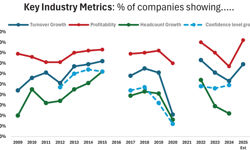Should you miss your last train home from that compelling credit-crunch commiseration party – and find yourself stranded at a London main-line terminal, look upwards. You may well see men on ladders putting up the next Store Takeover display at WH Smith. Every window and vacant space is being dressed with bright, colourful and striking messages from your favourite magazine brand. Colin Massie, MD of Absolute Concepts, the promotional company responsible for many such displays explains, "Network Rail only allow us access at night to hang displays and they have to approve the team we use."
Such are the lengths employed by major publishers to conjure up so-called retail theatre. But are such exploits purely the domain of the big brands who can foot the bill? Can smaller publishers take part? Do they work and, in particular, are they cost effective?
The expression ‘retail theatre’ conveys an impression of bringing life and movement to a brand image. Its relevance to the retail magazine market emerged in the early 2000s. In terms of floor space and indeed buyer time, magazines compete with other forms of entertainment media: DVDs, CDs and of course books. On your Saturday morning visit to WH Smith or weekly supermarket dash, you could encounter cardboard cut outs as diverse as a sinking Titanic, Shrek or Harry Potter’s car. "You have got to liven up the category", clamoured the buyers, "You need to inject fun into buying magazines."
The magazine publishers responded. There is now an array of imaginative promotional opportunities available for titles to dip into. Vendor income has become a key revenue stream for the multiple retailers themselves. The 2009 WHS Travel marketing opportunities pack runs to 44 pages, including of course the all important rate card – and even includes a free CD ROM. The High Visibility Windows promotion mounted by the midnight men on ladders will cost you £8,000 per week for Waterloo and Victoria - plus a cost for printed material that Colin Massie estimates to be £7,500. For £4,350, publishers can also dress Greeting Gates for a month in three key stores. Greeting Gates, by the way, are euphemisms for security scanners. Your favourite cartoon character can scream at you should you absentmindedly leave without paying.
204 million feet
The annual footfall of Waterloo Station is quoted as an astonishing 102 million people a year. Or 204 million feet! Every late September, IPC Media believe that a lot of those feet will be heading to the Southampton train for the city’s annual boat show. This year, their market leading portfolio of yachting and boating titles was promoted in a Drop Down Zone - fortnightly cost: £2,400 for five stores. An effective and targeted approach to a seasonal opportunity.
WH Smith lead the field in allowing publishers to reach huge audiences in an imaginative and appealing way. In particular, the travel sites should be applauded when one considers the cramped retail environments from which they are at times obliged to operate. Promotional plasma screens, branded doormats and exclusive gift merchandising bring life to the category. All important compliance is good. However, entry costs are not cheap and have limited appeal to smaller titles.
Borders have made an important contribution to the UK’s retailing scene in a relatively short period of time. Now operating 40 superstores, their 2009 marketing opportunities brochure proudly trumpets the PPA Destination Retailer of the Year award. When it comes to retail theatre, Borders have a huge advantage. Space. They have large stores in city centre locations with floor space that others can only dream of. Stores ooze a total-media and entertainment bias – with a heavy emphasis on music and movies. Martin Hoskins, trade marketing director for BBC Magazines is a fan. "The in-store environment is great for magazines – the atmosphere is relaxed and encourages shoppers to explore and browse magazines they previously may not have seen."
Borders’ offerings range from window promotions in high traffic city centre locations to central and end island units for exclusive free gifts. Sector promotions are run around sporting and national events. Spring and autumn fashion weeks are particularly popular with publishers. Costs are reflective of the retail estate and are more tailored towards smaller budgets and they conveniently include POS costs. A two-week till feature is only £500 – the most expensive is £4,000 for a window promotion. Volume discounts are available. This group supports specialist publishers and deserves their support in return.
Spaced out
It is easy to get carried away. At the start of each budget year, circulation managers can relax with a stack of retailer brochures and a coffee and choose their promotions for the next year. Remind you of choosing a holiday in the pre-internet world? But in this tough advertisement sales and circulation climate we all face, all promotions have to sell copies and further the objectives of the brand. This goes for theatre as well.
Tesco’s David Cooke is more sceptical. Far from convinced that the magazine category lends itself to retail theatre, he says, "Unless a sustainable customer offer is included, a lot of retail theatre is a waste of money and takes up valuable customer space."
Tesco have had their successes with mega-promotions. He cites a recent Emap ‘2 titles for £2’ and ‘£1 off Woman and Home with a Delia cookbook’ as the most successful.
Take a chunk of space
Bauer publish top selling titles in the women’s magazines sector with iconic brands such as Take a Break and That’s Life. They also publish a portfolio of puzzle magazines – often as brand extensions of their top selling titles. Many retailers love to hate puzzle books. Too many in the market and too much waste are common complaints.
To address the objective of selling more copies and reinforcing the links to Bauer’s top brands, the publisher is rolling out bespoke units displaying top selling Take a Break titles and its puzzle offspring in the same unit. Adoption by Martin McColl saw sales of puzzle titles increase by over 30% and plans are well advanced to place units in ASDA, Rippleglen and Mills. Simon Priston of Bauer was quite honest. "I took a punt with Take a Break and it worked."
Whist not being particularly theatrical, this promotion was typically workmanlike Bauer. There is close alignment of the customer profiles of Take a Break and Martin McColl and Simon was determined to mount a promotion he could measure and would deliver a customer offer from the shelf. The promotion is also very easy for hard-pressed store staff to manage. The rack quite clearly says Take a Break so only put Take a Break stuff in it. The success of the display is its simplicity - pulling brand extensions together. Priston commented, "We threw out perceived wisdom about display and concentrated on the brand."
Two golden rules
Is retail theatre worth the investment? Of course that depends upon how much you put in and how much you get out. Many good retail theatre type promotions are not for the faint-hearted when it comes to cost and coordination. There are experienced companies out there to help you – such as Absolute Concepts whose key executives have worked for major publishers – but an effective promotion means work. You will have to oversee designs, may have to source gifts and organise merchandising.
The rate card cost from the retailer may just be the start. Do not forget to cost in all important management time. POS must be very well designed and sturdy but, despite head office protestations to the contrary, there will always be the odd bolshie store who do not display as per the book. And then there are those frustrating customers!
One former MD of a major distributor, now a distinguished consultant, recalls a phone call when he was in the cab to Heathrow to catch a flight to spend Christmas in Australia. A so-called indestructible dump bin, full of Christmas TV listings, had collapsed on a child in a leading supermarket chain. No one was hurt, the child picked up and dusted down, but a nasty accident could have torpedoed that year’s listings sales in that group.
By its very nature, theatre commands space and space will command copy. Experience shows that whilst sales can increase with the right offer – unsold levels can go through the roof as copy is committed to fill huge dispenser units or metres of shelf space.
Never forget the two golden rules. Firstly - investment in theatre must support a sustainable consumer offer. Recently, Glamour dressed the stores at Waterloo and Victoria and combined display with an exclusive free gift in-store. Secondly - ensure that the underlying promotional strategy and execution support the brand message.
Those publishers who can afford it, do continue to brighten up our retail experiences. Whether it’s Dr Who or Superman, a free gift or a quid off, good theatre will drive sales and continue to reinforce the importance of the magazine category to retail buyers. Just get your budgeting right as it may not always be upside...
FEATURE
Curtains up
Publishers and retailers talk about the need for retail theatre. A bit of colour and a bit of pizzazz will bring the category to life, boost the brand and increase sales. Well, that’s the theory. The downside is that it takes a lot of work and doesn’t come cheap. David Stam looks at the pros and cons.










